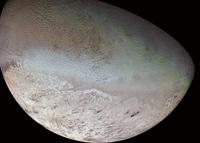The largest of all moons of Neptune, Triton

Due to its special characteristics, since the first photographs arrived on Earth, Triton attracted the attention of the researchers. Moreover, this Neptune satellite was the protagonist of the last phase of Voyager 2's journey. However, before Voyager 2 arrived in Triton, a characteristic that distinguishes the satellite from everyone else in the solar system was known: Neptune spins around its axis against the clock hands, while Triton moves around the planet like the clock hands. And this does not happen anywhere else in the solar system.
For astronomers it has another mystery. Its atmosphere is very fine, but however, its surface is very small, much less visible than other planets and satellites of this type. It is a little smaller than the Moon and as far as its size and density can be said that Pluto and Triton are very similar. Apparently, Triton is made up of a mixture of rock and ice, and not just ice, as some astronomers believed.
The atmosphere resembles that of Titanium. Along with this satellite and the Earth of Saturn, they are the only ones with nitrogen as their main component. Besides nitrogen, it has some methane. The layers of clouds you have seen in Triton are formed by icy nitrogen.
It is colder than any other object of the Solar System, with a surface temperature of -235 °C. The surface of Triton absorbs very little solar radiation.
Once all these characteristics are commented, do not think that everything ends there. We have to count more.
Voyager 2
Voyager 2 has been the only spacecraft that has approached Triton. It was in August 1989. And actually, the Voyager 2 cameras received curious data. Perhaps more surprising than jewelry.

Few expected to find the young surface of Triton and of diverse geological structure. And so it was, they found no trace of icy and slow skin. On the contrary, they saw wide canyons, craters, peaks, icy ponds and huge cracks. But the most surprising discovery was undoubtedly that of volcanoes.
Triton, Io and Venus are, in addition to the Earth, the only currently active volcanic systems in the solar system. It was also Mars. But as for the eruption, they are all very different. For example, terrestrial and Venus volcanoes emit stony material, sulfur ion and/or sulfur compounds, and triton, volatile compounds such as nitrogen and methane.
As you can see, there is something to analyze in this unique remote satellite. In addition to physical characteristics, geological incidents also have a lot to say. And, if that were not enough, the process of creation of Triton also generates many doubts among the experts, since it has not yet been resolved if it had formed like other satellites of the solar system.
Neptune
In the gaseous giants, Jupiter, Saturn, Uranus and Neptune itself, is the planet furthest from the Sun. Gas giants are impressive planets formed mainly by gases. Neptune, with atmosphere, is almost 60 times greater than the Earth. Then take the bills.

Neptune is surrounded by an eight-moon system. All these moons are usually small, but there is one that is big and special, Trito.
The composition of Neptune is similar to that of Uranus, quite uniform. However, it has a small solid core to Earth size. The atmosphere is mainly hydrogen (85%) and
helium (13%) and contains some methane (2%).
As on any gas planet, strong winds and storms occur in Neptune. Its wind gusts are the strongest in the solar system, reaching a speed of 2,000 km/h.
Like Jupiter and Saturn, Neptune also has an internal source of heat that radiated more than twice the energy it receives from the Sun. And the days are somewhat shorter than on Earth, 16 hours and 6.7 minutes.
Neptune's diameter is approximately four times larger than Earth's. In addition, it is the densest planet of the giant
planets. Neptune appears in blue. Why? Methane is primarily responsible for this. In fact, methane in the atmosphere absorbs red light, which in the spectrum appears in small wavelengths. And it reflects everything it does not absorb: the highest wavelengths of the spectrum or the blue zone. That's why you see the blue of Neptune.





